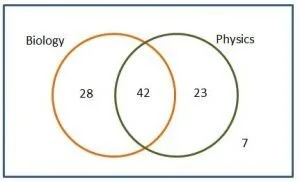Understanding conditional probability in IB Maths Applications & Interpretation
Written by Ian Lucas
Understanding the problems
Conditional probability appears difficult, and I think that's because it comes with yet another probability formula seemingly designed to confuse students! But forget the formulae for a moment, and consider these two problems:
Two dice are thrown. What is the probability that:
a) The total on the dice is both greater than 9 and a double.
b) The total is a double given that it is greater than 9?
In this blog, I will indicate the result of throwing two dice like this: [5,6]
In problem (a) we have no information, so the total could be any one of the 36 possibilities. Only two of these are both greater than 9 and a double, and these are throws of [5,5] and [6,6]. So the answer is 2⁄36. But in problem (b) we are given extra information which affects the outcome. Why? Because if the total is greater than 9, it has to be one of [4,6], [5,5], [6,4], [5,6], [6,5], [6,6] and since two of these are doubles the answer is 2⁄6. And there we have a conditional probability: the probability of one event happening given that something else has happened. The symbol for this is a vertical line: P(A|B).
Independent Events: In some cases, the events do not affect each other. For example, if you flip a coin and then throw a die, P(throw a 3|tails on the coin) is exactly the same as P(throw a 2) since it makes no difference what the outcome of the coin flipping is. Such events are called independent, in which case
P(A|B) = P(A|B') = P(A). ie P(3|tails) = P(3|heads) = P(3).
Suppose you have a bag with 6 green beads in it, and 4 red ones. Take a bead out, and then a second bead. What is the probability the second bead is green given that the first is red. Well, there are still 6 greens left, but only 9 beads, so the probability is 6⁄9. But what if the first bead was green? There are now only 5 greens left out of 9 beads, so we get 5⁄9. The two events (first bead and second bead) are not independent because the colour of the first affects the colour of the second. However, if we had replaced the first bead before drawing out the second, the events would be independent: the colour of the first would have no effect on the colour of the second, and P(second is green) = whatever colour the first bead was.
Conditional probability formula: To derive the conditional probability formula, let's look at a Venn diagram. This shows, for the hundred students in a year group, the numbers who study Biology and Physics.
Look at these probabilities of what a student taken at random studies:
P(Biology) = 0.7
P(Physics) = 0.65
P(Biology and Physics) = 0.42
P(Biology|Physics) = 42⁄65 = 0.646 (since of the 65 who study Physics there are 42 who study Biology)
This leads to the general equation for conditional probability: P(A|B) = P(A ∩ B)⁄P(B).
Let's put it all together: So we can see that although the proportion of the year group who study Biology is 70%, this reduces to 64.6% of those who study Physics. We would expect the probability of a student studying Biology who does not study Physics would be higher than 70%. In fact it is 28⁄35 = 0.8.
Now let's change the numbers a bit:
70% of the group still study Biology, but also 70% of the Physicists study Biology. The conditional probability P(B|P) = 42⁄60 = 0.7. So now the probabilities of studying Biology and Physics are independent since it doesn't matter whether or not a student studies Physics, the probability the students studies Biology is always 0.7. You might like to show that P(B|P') is also 0.7.
Finally, let me point out that P(Physics) × P(Biology) = 0.7 × 0.6 = 0.42, which is also
P(Physics ∩ Biology). This is the test for independence: events A and B are independent if P(A ∩ B) = P(A) × P(B).
Looking for more Maths Applications and Interpretation support
This article was written by Peak IB author and IB educator, Ian Lucas. In his series of IB study guides, Ian explores in-depth the content you will need to understand and the skills you are required to develop in order to be a successful Maths AI student. You can get a copy of his study guide for Standard Level study or Higher Level study through our online store.
If you are looking for more insights into particular elements of the Maths AI syllabus, check out Ian’s article What’s significant about Significant Figures in IB Maths Applications and Interpretation on our IB Maths Applications and Interpretation subject resource page.





